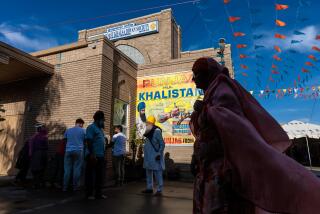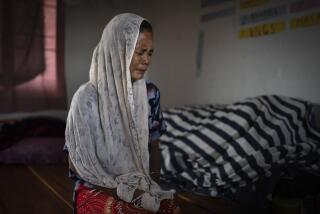In the Valley of Kashmir, a Struggle for Freedom Amid Fears of War : Rebellion: Kashmiris say they want independence, and friendly relations with both India and Pakistan. India’s answer is the whip.
- Share via
SRINAGAR, KASHMIR — Anyone walking the streets of the capital of Kashmir cannot fail to notice, at this time of year, the still snow-capped hills surrounding the town--some just beyond its outskirts, some farther away. Those hills have helped produce the Kashmir problem.
And no one could fail to notice the presence on the streets of very large numbers of heavily armed men of the Indian army and paramilitary forces: In some places on guard every 100 or even every 50 yards, behind sandbagged bunkers, both stationary and in trucks. They are the Kashmir problem today, as India and Pakistan move ominously closer to war over this disputed area.
Over the centuries, the hills have cut off the already remote Valley of Kashmir from the rest of the Indian subcontinent--especially for the three or four months of winter when the passes across the hills are snowbound.
This isolation has helped produce what is called Kashmiriat-- a close sense of a community, of a people--which has its own distinctive identity and culture and tradition. This goes back to the centuries before Christ; when the Kashmiri Hindus adopted Buddhism, they did so en masse, then returned to Hinduism en masse and later accepted Islam en masse: Now less than 5% of the Kashmiris are Hindus.
Today Kashmiriat solidarity is all too evident in the political sphere. The region was divided between Pakistan and India following fighting in 1947-48; their troops now face each other along a cease-fire line.
I have been meeting with Kashmiri journalists, lawyers, social workers and doctors, engineers, hoteliers and the inevitable taxi drivers. With one accord of heart and voice--an angry voice--they say they want nothing more to do with India. Finito. Unanimously, and only a little less vehemently, they say they want azadi --independence--with equally friendly relations with both India and Pakistan. When a people, even if only 3 million or 4 million strong, say with unanimity that they want to run their own affairs, the jinni is out of the bottle and it would be almost impossible to get it back in.
Kashmiriat is seen in action, peaceably, when a demonstration is called and hundreds of thousands of people turn out, sometimes half the population of Srinagar, and most significantly for this conservative society, with women in the vanguard. And it is seen in action, violently, in the guerrilla war being waged by the militants, the fish swimming freely in the water of their people. The Kashmir resistance has already settled into the pattern of the Palestinian intifada, ongoing violence with incidents of some sort every day: And the intifada has lasted for 2 1/2 years now.
In short, however many troops India puts into the valley--20,000 so far--it will never be able to end the azadi movement. It may suppress it for a time, but only for a time. The firm Kashmiri determination to be free is now a fact that is, or should be, as obvious as the surrounding hills.
As in other struggles, repression only toughens the resistance. The Kashmiris I talked to all spoke with special bitterness of the 17-day-long, round-the-clock curfew imposed on the valley last month--the holy month of Ramadan--by Jagmohan, the appointed Hindu governor who uses a single name. During that period not even the seriously ill, women in labor (500 births a day), the starving who had run out of food--no one was allowed to leave the house: Only the dead and a few mourners were allowed out. Yet the Kashmiris say “We are thankful to Jagmohan; he toughened us and united us in hardship and suffering and he fully revealed the ugly face of the Indian government.” In extremis they fall back on the inbred stoicism of Islam.
The ineptitude of the Indian regime’s military doctrine, and its inability to cope with armed insurgency, is being displayed once again in Kashmir, as earlier in Sri Lanka. A typical incident: In the sprawling, congested and slum-filled area of the town, a couple of militants emerge from a narrow alley and snipe at a passing patrol, then dive back into cover. The patrol whistles up reinforcement, finds no one when it arrives and in frustration roams the locality, killing civilians of all ages. This is called “killed in cross-fire.” Or a “combing” operation is mounted with house-to-house searches: It has been estimated that three out of every 10 houses searched are trashed. There are random arrests, followed by torture. I have seen gruesome color photographs of torture victims.
Since January, about 350 civilians have been confirmed as killed by the Indian forces; the number of casualties inflicted by the militants among the forces is never revealed, but range upward of 1,200; 100 civilians--40 Hindus, 60 Muslims, suspected of being traitors or informers--have been killed by the militants.
Those last figures, set against the routine assumption that the Muslims would, at the first opportunity, take it out on the much smaller Hindu community, emphasize an aspect of Kashmiriat of which the Kashmiris are particularly proud: Kashmiri secularism. The state has always been singularly free of what are called “communal incidents.”
Kashmiris accuse Gov. Jagmohan of trying to drive a wedge between Muslims and Hindus who, though small in number, virtually monopolize the higher ranks of the bureaucracy in business and commercial life. Mysterious rumors were floated of a Hindu pogrom, and the government then provided official transport to take the “refugees” to Hindu-majority Jammu, where facilities were generously provided for them. Individual Muslims and the militant groups, in advertisements and newspapers, pleaded with the Hindus not to leave, because Hindus in fact had not been attacked. The houses they left behind, often looked after by Muslim neighbors, have not been sacked.
Only when the summer heat of Jammu became too much for the Kashmiri Hindus did the bureaucrats return to this capital city, leaving their families behind in Jammu. The bachelor returnees are now housed in government hostels and are ferried to the heavily guarded Secretariat in guarded buses along roads cleared of all other traffic--a visible symbol of the Jagmohan regime’s total alienation from the Kashmiri man-in-the-street.
“Whatever the authorities say, this is a nationalist, not an Islamic, struggle,” said the supreme spiritual head of the Kashmiri Muslim community. In an interview, he conceded that about half the militants are in groups with Islamic names and call for an Islamic state linked to Pakistan. But the other half are members of the Jammu and Kashmir Liberation Front, which is militantly secular.
Jagmohan’s harsh policy is killing off any hope of a negotiated political settlement. This, the Kashmiris say, could be deliberate, because Jagmohan is receiving strong political support from a right-wing Hindu party in India, which has talked of changing the Kashmiri Muslim majority into a minority by bringing in Hindu settlers.
Jagmohan has seen to it that the news is doctored in his favor. Foreign correspondents have been banned from Kashmir, 11 local daily newspapers shut down, the two national news agencies of India frightened into moving their bureau from Srinagar to Jammu (akin to covering the Vietnam War from Bangkok). Radio and TV are government departments and consistently fudge the casualty figures. The Indian media are just beginning to assert their critical independence.
Here is one case where it might be a good thing for the United States to “interfere” in what India obdurately claims is a domestic matter--as blasphemous as that might seem coming from this Indian correspondent. It would be better still if the United States did so in conjunction with the Soviet Union. Because India and Pakistan have painted themselves into corners: Jagmohan, by arresting all the leading figures, has left him and India with no one to talk to.
What the Kashmiris want is a plebiscite on independence, leading to a tripartite confederation. It could lead to the partitioning of the present state of Jammu and Kashmir, because Hindu Jammu and Buddhist Ladakh would prefer to stay with India.
But even that would be much the lesser of two evils--less evil than the endless bickering over an issue that has led to two Indo-Pakistan wars and could lead to a third.
Washington should capitalize on the current fluidity in the Kashmir situation and try to save India and Pakistan from themselves. But the United States must grasp one reality--the Kashmiris will never settle for anything less than self-government. They plaintively ask: “Why can’t the two sides just leave us alone?”
Good question.
More to Read
Sign up for Essential California
The most important California stories and recommendations in your inbox every morning.
You may occasionally receive promotional content from the Los Angeles Times.













